The Mediterranean diet is the only nutritional system that has a phenomenal number of fans who follow its rules not only to lose weight, but to improve the health of the entire body, which ultimately leads to active longevity.
Essence and fundamental principles
The peculiarity of the diet is that it is not a set of rules, principles and restrictions artificially created by nutritionists that you always want to break.
This is the result of observing the community of a given region, comparing the morbidity statistics of its population with the rest of the population of the planet, identifying the reasons for its superiority, and adapting the region's traditional diet to other villages.
The term "Mediterranean diet" was first introduced in the mid-20th century by the American couple A. and M. Case, who, while studying the dependence of cardiovascular diseases on diet, came to an unexpected conclusion.
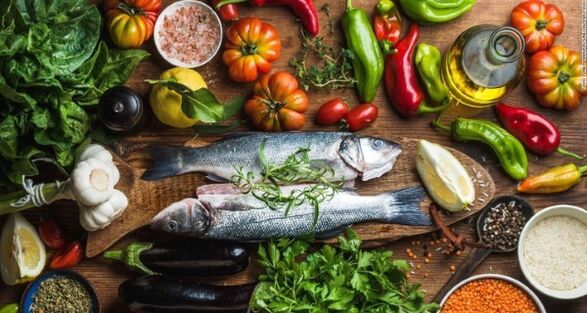
It turned out that Italy, where nutritionists published their scientific works on heart disease, differs from their country of origin in that the local population, consuming enough fatty and high-calorie foods, is not obese and is less susceptible to diseases of the circulatory system, hypertension and diabetes.
This served as an impetus for new research work in Italy, and then for confirmation of the idea in Japan, Germany, Finland and Yugoslavia.
Ansel and Margaret Case's sensational discovery prompted American scientists, concerned about the nation's level of disease and rapid "obesity", to use their research to create a "preventive medicine" program in the 1970s. In essence, these are the systematized foundations of the traditional nature of the diet of the inhabitants of the Mediterranean countries.
The popularity of the diet has been very high for half a century, which proves its simplicity and effectiveness, and the UNESCO organization has recognized the cuisine of 12 Mediterranean countries as national cultural heritage. Unlike other diets, the Mediterranean diet has no time limits.
It should become a way of life, transforming its food advocates into residents of the Mediterranean region. Which is not at all difficult, given the simple principles and availability of the necessary products in all stores. The Mediterranean diet to lose weight means following some rules that quickly become a habit.
To do this you need:
- move to 6 meals a day (3 main and 2 additional, called snacks);
- make seasonal (not greenhouse) vegetables, fruits and berries the basis of the diet;
- focus on fish and seafood in your diet;
- use only olive oil in the kitchen, using it both for cooking and for dressing salads;
- eat legume-based dishes every day;
- reduce sugar consumption to a minimum by replacing it with honey;
- drink only dry red wine, refusing other alcohol;
- consume at least 6 tablespoons. clean water daily;
- lead an active and mobile lifestyle.
To better understand these simple rules, the so-called "Mediterranean diet pyramid" was developed. Closer to the base, which occupies the largest volume of the geometric figure, are foods that should be consumed several times a day.
This:
- rice, millet, bulgur, durum wheat pasta, cereal bread;
- fruits and vegetables;
- fermented milk products, cheeses;
- nuts, dried fruit.
Furthermore, closer to the top of the pyramid, i. e. occupying a significantly smaller volume, there are food products with a consumption limit of 1 to 6 times a week.
This:
- fish dishes;
- poultry meat;
- Potato;
- chicken eggs;
- sweet sweets.
At the top of the pyramid is meat. Italians prefer beef and lamb and almost never eat pork. In countries where the main meat-based diet is pork, it makes no sense to deviate from the generally accepted product, just choose lean cuts.
Therefore, a visual distribution of priority products allows us to reduce the diet to the following daily diet:
| Product name | % of food consumed per day |
|---|---|
| Cereals and legumes | 35 |
| Vegetables, fruits, greens | thirty |
| Fermented dairy products, cheeses, fish, meat | 20 |
| Olive oil | 10 |
| Sweet desserts | 5 |
An important point: when to eat from the listed products.
The distribution of the diet over time is as follows:
- cereals, cereals, chicken eggs, vegetables, fruits - breakfast;
- fermented milk products, fruit - 2nd breakfast;
- soups, pasta, rice, vegetable salads, meat, fish, fruit - lunch;
- fruit salads, fermented dairy products, cheeses – afternoon snack;
- fish, vegetable casseroles, salads, seafood, cheeses, fruit - dinner.
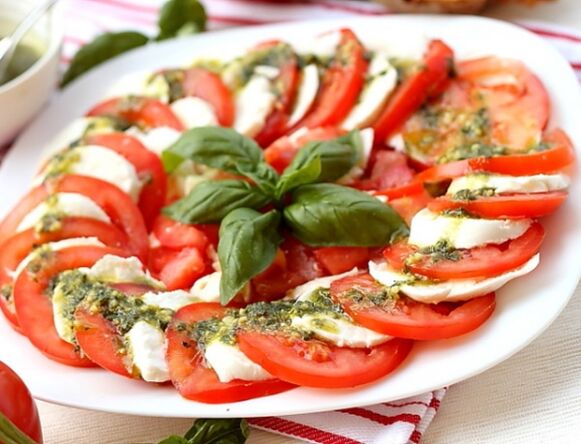
Therefore, looking at the list of allowed foods and the distribution of their consumption during the day, we can conclude that you will not have to starve. Furthermore, good red wine is a daily bonus in the Mediterranean diet. Sweets are also allowed - once a week (Italians and French are famous lovers of sweets, but in moderation).
However, to begin the process of losing weight (that is, this is the goal of switching to diet nutrition), you need to remember the amount of food you eat. The volume of food consumed in one meal should not exceed 240 ml (visually it is 16 tablespoons. L. or 1 tablespoon. ).
The Mediterranean diet for weight loss does not produce immediate results. Using a balanced menu, abundant meals and small restrictions in their life, supporters of these principles, as a rule, continue to live, observing them further, and after some time they notice improved health, significant weight loss and the need for a renewed body to move actively.
Contraindications for use
The success of the diet is due to three factors:
- low in animal fats and sugars;
- high content of dietary fiber, fiber;
- rich in omega-3 fatty acids and antioxidants.
Although the Mediterranean fasting diet is a well-balanced eating method, it has contraindications.
This combination is unacceptable for some people:
- Highly obese people will not be able to achieve the expected results by changing their diet. In this case, special and radical methods are needed to regulate weight.
- Such a set of foods with a high level of fiber can be harmful to diseases of the gastrointestinal tract.
- Allergy sufferers who react to seafood or other important components of the Mediterranean diet should avoid it.
Main menu of the week
After a while, getting used to the Mediterranean diet and its features will help you create a balanced menu for the day, taking into account the rules, your preferences and capabilities. Until then, you can use the recommendations of nutritionists.
| Days of the week | Main meals (excluding snacks) | ||
|---|---|---|---|
| Breakfast | Dinner | Dinner | |
| Monday |
|
|
|
| Tuesday |
|
|
|
| Wednesday |
|
|
|
| Thursday |
|
|
|
| Friday |
|
|
|
| Saturday |
|
|
|
| Sunday |
|
|
|
Mediterranean Diet Recipes
The Mediterranean diet for weight loss is distinguished by a wide choice of dishes for creating a menu.
It is important to remember that:
- Olive oil is used in cooking, a source of polyunsaturated fatty acids and lipids, which can sometimes be replaced with another vegetable oil;
- the consumption of bread is limited, and must be made from cereals, coarsely ground;
- food must be prepared without the use of store-bought sauces or canned products that contain electronic additives;
- dairy and fermented milk products should be low-fat;
- in dietary nutrition, the consumption of any sea fish is encouraged: herring, mackerel, cod, hake, pike perch, perch; the fish should be steamed, grilled, boiled or stewed, avoiding frying;
- White poultry or rabbit meat can be included in the diet 2-3 times a week, red meat (beef, lamb, lean pork) - no more than 2-3 times a month. It must also be boiled or stewed;
- salt is used in small quantities, it is well replaced with lemon juice and spices; sugar is completely excluded, you can use a little honey;
- We must not forget the drinks: any tea, herbal tea, coffee are allowed; simple clean water is needed;
- wine must be red and dry, which helps reduce appetite, normalizes gastric acidity, participates in hematopoiesis and lowers cholesterol;
- Store-bought sweets that are high in sugar, fat and palm oil are excluded from the diet.
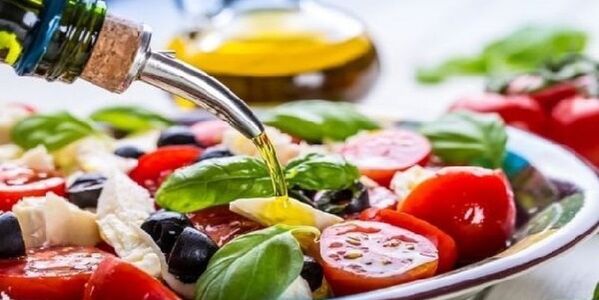
Summer salad (with chicken)
A hearty and easily digestible salad has an unusual, spicy and fruity taste, thanks to the combination of its ingredients.
Composition of ingredients
Composed:
- boiled chicken breast – 150 g;
- fresh peaches – 2-3 pieces;
- canned pineapple – 50 g;
- celery stalks – 2-3 pieces;
- any lettuce leaves – 150 g.
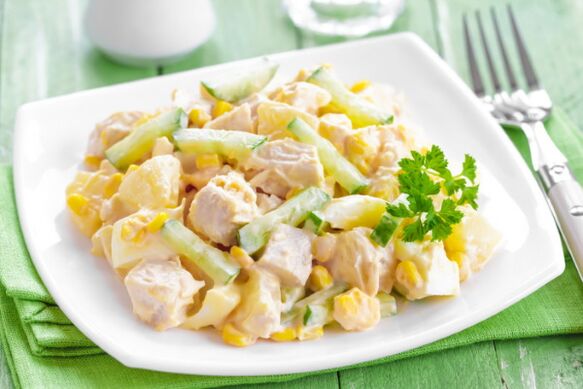
For the dressing you need low-fat natural yogurt without additives (1/2 cup), mint, cinnamon, lemon zest.
Step by step cooking process
Summer salad is prepared in 3 stages:
- The procedure should start by preparing the base of the salad: you need to cut the chicken breast, peaches, pineapple and celery into cubes. It is best to tear lettuce leaves with your hands.
- To prepare the dressing, place the yogurt in a separate bowl, add the cinnamon, lemon zest and chopped mint leaves.
- Next, you need to add the dressing to the salad base and mix gently.
What can I add?
The salad will remain tasty, healthy and consistent with the rules of the Mediterranean diet if:
- use turkey meat instead of chicken;
- peaches can be replaced with nectarines and pineapples with orange pulp.
This type of salad will remain a healthy, low-calorie and satisfying dish.
How to serve a dish
Summer salad is easy to make any season by purchasing imported peaches or oranges. It's great for dinner with a glass of dry red wine. The dish can be decorated with lettuce leaves and pieces of fruit left aside.
Salad with basmati rice
The Mediterranean diet for weight loss is known for its cereal salads, in which you can combine poultry, fish or vegetables with cereals to obtain dishes that are varied in taste, but satisfying and healthy.
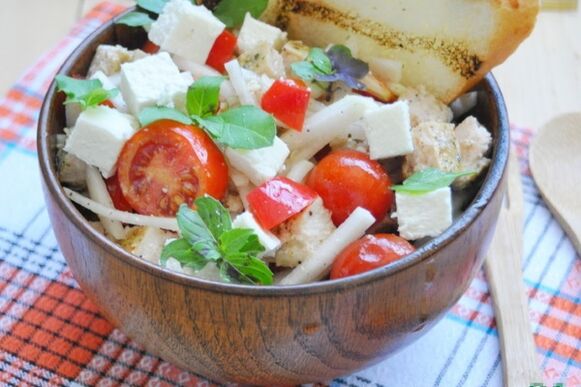
One of these salads is below.
Composition of ingredients
Composed:
- basmati rice – 1 tablespoon;
- feta cheese – 60 g;
- dried tomatoes – 2 pieces;
- peanuts - 2 tbsp. L. ;
- mint;
- olive oil;
- spices;
- water (for 200 g of rice - 250 ml of water).
Step by step cooking process
Basmati salad is prepared in 6 steps:
- Basmati rice must be washed and then soaked for 15 minutes. in warm water, which will help the beans to more fully reveal their taste and aromatic properties.
- Then you should continue cooking in the same water, after boiling, reduce the heating temperature. After boiling the grains for 20 minutes, set the pan aside and let the grains sit in the hot pan for another 15 minutes. Only then can you mix the rice with a fork.
- At this time, dried tomatoes should be poured with hot water and kept in for 10 minutes, then dried with paper towels and cut.
- Toast the walnuts and chop them together with the feta.
- Add tomatoes, cheese and nuts to the cooled rice - this is the base of the salad.
- Add the chopped mint, spices and drizzle with olive oil.
What can I add?
You can use other dried fruits in this dish: pine or walnuts, which is quite suitable for the Mediterranean diet.
How to serve a dish
The dish can be served for lunch or dinner, garnished with a sprig of mint.
Cream cheese soup with seafood
The Mediterranean diet allows the consumption of large quantities of fatty foods such as cheese.
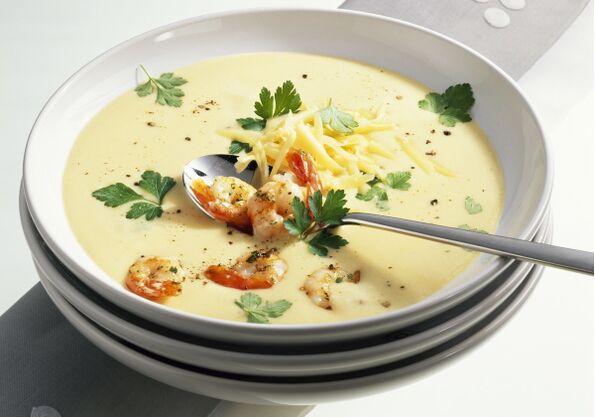
They appear on the table almost every day, served as an appetizer, at the end of the meal with dessert, or in the preparation of a hot meal.
Composition of ingredients
Composed:
- hard or semi-hard cheese – 200 g;
- processed cheese – 100 g;
- shrimp – 150 g;
- mussel meat – 100 g;
- cream (20%) – 200 ml;
- chicken egg (yolk) – 1 pc. ;
- carrots – 1 pc. ;
- onions – 1 pc. ;
- wheat flour – 1 tbsp. L. ;
- wine vinegar - 1 tbsp. L. ;
- olive oil – 1 tbsp. L.
Step by step cooking process
Cream cheese soup is made in 5 steps:
- To prepare the broth it is necessary to boil the prawns and mussels, peel them, filter 200 ml of liquid and pour them into a saucepan to prepare the soup.
- The peeled and chopped onion should be fried in a small amount of olive oil until it becomes transparent and, adding pieces of carrot, it should be kept on the heat a little longer.
- Place the cream in a saucepan with the broth, bring to the boil and, placing it on a low heat, add the grated cheeses. The broth should be stirred continuously until the cheeses have completely melted.
- The next step is to collect the mixed egg yolk, the overcooked vegetables and the flour diluted in a little water in a saucepan. While you stir the soup, bring it to a boil and cook for 5-7 minutes.
- It is necessary to "punch" the contents of the pan with a blender, achieving the desired consistency using the remaining broth.
What can I add?
To enhance the taste you can use the broth left after cooking the boiled fish.
How to serve a dish
Soup is served during lunch. The contents of the dish are sprinkled with herbs.
Courgettes with feta
Oven-cooked vegetables are a great option for a healthy dish that requires little time in the kitchen.
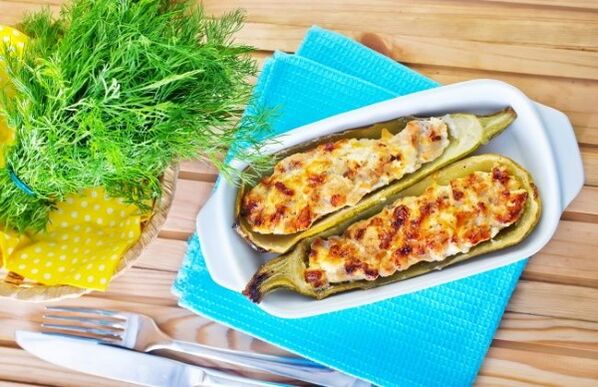
One option is courgettes with feta.
Composition of ingredients
Composed:
- courgettes (small) – 4 pieces;
- feta cheese – 200 g;
- garlic – 1 clove;
- olive oil – 1 tbsp. L. ;
- mint;
- spices;
- pine nuts.
Step by step cooking process
Courgettes with cheese are prepared in 4 steps:
- To prepare the courgettes for cooking it is necessary to wash them; Peel the old fruits from the peel, leave the young ones with the peel; cut it lengthwise into two parts and remove the pulp.
- Next, fry the chopped pulp in olive oil with garlic, passed through a garlic press.
- Add the remaining ingredients to this mixture: chopped feta cheese and mint, nuts and spices. Mix everything carefully.
- Fill the courgette "boats" with the prepared filling and bake at 220°C for 30 minutes.
What can I add?
You can also cook courgettes and aubergines and use semi-hard cheese instead of feta.
How to serve a dish
The dish goes well both alone and with a side dish of boiled brown rice. Or you can use it yourself as a stewed vegetable for chicken breast or turkey. Zucchini will be beautiful with parsley.
Baked fish with cheese
Fish is a frequently consumed food in the Mediterranean diet. During the weight loss period it should be consumed boiled or stewed.
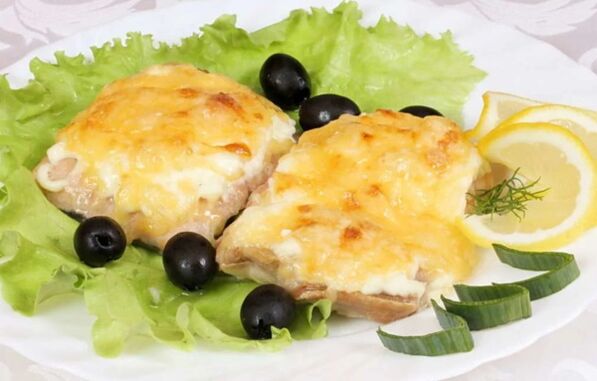
By changing the type of fish, you can change the calorie content and taste of the dish, while maintaining its health benefits.
Composition of ingredients
Composed:
- fish fillet – 200 g;
- low-fat kefir – 50 ml;
- semi-hard cheese – 70 g;
- olive oil – 1 tbsp. L. ;
- lemon juice – 1 tbsp. L. ;
- dill.
Step by step cooking process
Fish with cheese is prepared in 4 steps:
- The baking tray must be greased with oil and the pieces of fish placed on it.
- The seasoning is prepared in this way: you need to combine kefir, juice, aromatic herbs and mix everything. The mixture must be carefully poured over the portions of fish.
- Grated cheese should be sprinkled on top of each piece.
- The products must be stored in a preheated oven at 180°C for 15 minutes.
What can I add?
You can add chopped peppers to the mixture or place a slice of tomato on top of the fish.
How to serve a dish
The fish can be decorated with herbs and thin lemon leaves.
Pasta with peas
The Mediterranean diet includes pasta (pasta) among the foods allowed for consumption, appreciated not only in Italy.
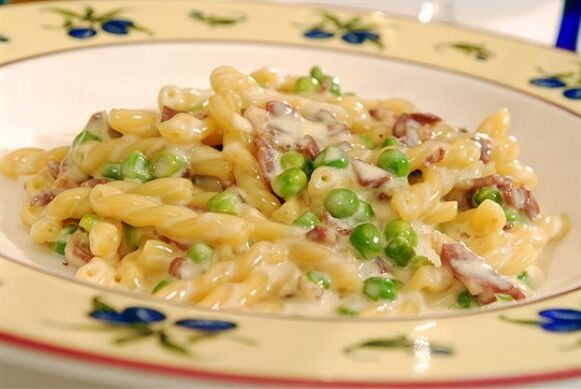
There is no certainty that significant weight loss can be achieved by eating them, but nutritionists believe that category "A" pasta, made from durum wheat, does not lead to weight gain.
Composition of ingredients
Composed:
- pasta category "A" – 200 g;
- semi-hard cheese – 200 g;
- peas – 0. 5 tablespoons;
- pepper – 1 pc. ;
- olive oil;
- lemon juice.
Green peas can be used fresh frozen, it is much better than canned ones.
Step by step cooking process
Pasta with peas is prepared in 3 steps:
- The pasta must be boiled al dente; the cooking time is always indicated on the package.
- Next, boil the peas until half cooked and fry them in olive oil with finely chopped pepper.
- It is necessary to combine hot pasta with peas, pepper, grated cheese and add lemon juice to taste instead of salt.
What can I add?
Boiled pasta can be combined with many foods and sauces, creating dishes with different tastes and satiety.
How to serve a dish
Before serving you can add the rocket leaves to the dish.
Oat muffins with almonds
Sometimes you can treat yourself to some homemade desserts.
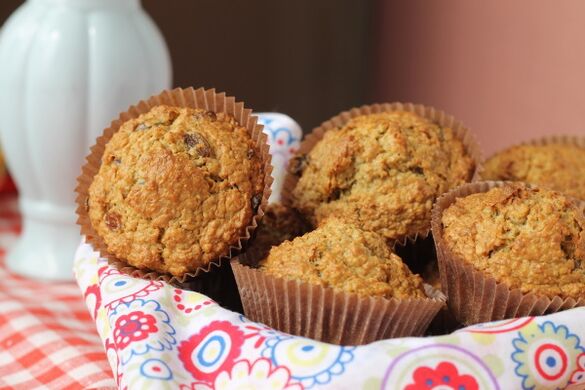
In this case you will certainly know the composition of the ingredients and you will be sure of the absence of preservatives and harmful additives.
Composition of ingredients
Composed:
- oatmeal – 4 tbsp. L. ;
- chicken egg – 2 pieces;
- powdered milk – 4 tablespoons. L. ;
- baking powder – 20 g;
- almonds – 10 gr.
Step by step cooking process
Oatmeal muffins are prepared in 4 steps:
- To prepare the dough you need to mix the "dry" ingredients: cereals, milk, yeast, chopped nuts.
- The eggs should be beaten and carefully added to the "dry" mixture.
- The resulting dough should be placed in silicone molds, which do not need to be greased with oil.
- The muffins should be placed in a preheated oven at 200°C and cooked for 15 minutes.
What can I add?
Any chopped nuts, dried fruits or fresh fruits are suitable as an additive to the oat milk mixture.
How to serve a dish
The dessert can be served garnished with a mint leaf or fresh berries. For greater pleasure, you can prepare teas or herbal infusions.
When to expect an effect
People who switch to the Mediterranean diet note that, without much effort or discomfort, they begin to notice positive changes in their health and figure after about 3-4 months. Gradual weight loss, almost imperceptible at first, reaching an average of 3 kg within six months.
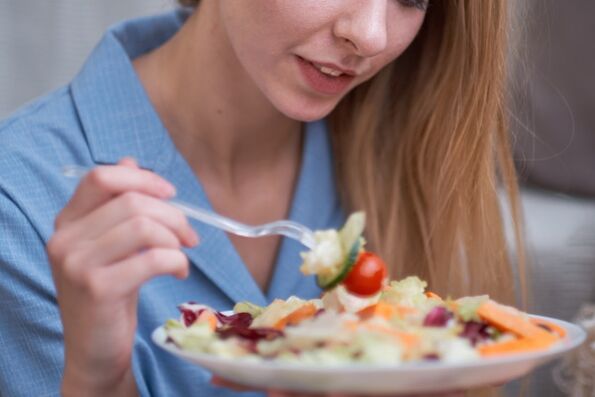
Becoming fans of tasty and healthy food, people stop focusing on their kilograms, and after 2-3 years 10-15 kg disappear unnoticed. After reaching optimal weight, the body independently reaches a state of equilibrium.
The Mediterranean diet is not a change in diet for rapid weight loss with rapid weight restoration at the end of the course. This is a change in lifestyle, in attitude to the world around you, to yourself, to your body and your body, giving them the attention they deserve.
































